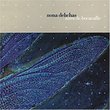| All Artists: Dmitri Klebanov, Igor Blazhkov, Richard Kapp, Philharmonia Virtuosi [members of], Philharmonia Virtuosi of New York, Natalia Biorro Title: Dmitri Klebanov: Japanese Silhouettes; Viola Concerto Members Wishing: 0 Total Copies: 0 Label: Essay Release Date: 5/27/1997 Genres: Pop, Classical Styles: Vocal Pop, Opera & Classical Vocal, Chamber Music, Forms & Genres, Concertos, Historical Periods, Classical (c.1770-1830), Instruments, Strings Number of Discs: 1 SwapaCD Credits: 1 UPC: 090998105221 |
Search - Dmitri Klebanov, Igor Blazhkov, Richard Kapp :: Dmitri Klebanov: Japanese Silhouettes; Viola Concerto
 | Dmitri Klebanov, Igor Blazhkov, Richard Kapp Dmitri Klebanov: Japanese Silhouettes; Viola Concerto Genres: Pop, Classical
|
Larger Image |
CD DetailsSimilarly Requested CDs
|
CD ReviewsOne of my favorite modern pieces Joshua Saulle | Yonkers, NY USA | 04/24/2001 (5 out of 5 stars) "This disc contains the two last works of an obscure Russian master named Dmitri Klebanov, who was ostracized from the Stalinist guild of composers in the 1940s and spent the next 30 years of his life in creative exile in the Ukraine, writing almost nothing until the thaw in the 1980s, when Mela Tenenbaum, the violist on this disc, befriended him and renewed his creative energies. He wrote both of these works for her, but died before he could hear Japanese silhouettes premiered. After the premieres, the music was lost in the disintegration of the communist musical institutions of Russia, until Mela Tenenbaum in her new home as concertmaster of the Philharmonia Virtuosi, and the conductor Richard Kapp undertook to find the manuscripts and reunite the performers and conductors who had given the premieres of both works. not only is this an incredible story, but the music on the disc os fully worthy of it. These works show Klebanov to be on a par with his contemporary Shostakovich, indeed in some places more forward looking in his use of dissonance and in his use of exotic percussion and Japanese instruments in the Silhouettes. The viola concerto is a dramatic, tense and emotional work reflecting much of the artistic frustration Klebanov felt at his de facto exile. It is modern music that is both accessible and expressive while using a modern musical vocabulary. I highly recommend this disc to all with an interest in music of any era." An Essential! Joshua Saulle | Yonkers, NY USA | 11/18/1999 (5 out of 5 stars) "Dmitri Klebanov was a promising composer in Stalinist Russia with a bright career ahead of him when Stalin made his infamous attack on Soviet artists. The Soviet Composers' Union adopted the unwritten rule that one composer would be selected to take the heat for all of them-- Klebanov was it. Following thirty years in de facto exile, Klebanov thawed out with the rest of the USSR in the 80s. He befriended Mela Tenebaum, for whom he wrote these works. Unfortunately, he died not long after finishing Japanese Silhouettes, and was not able to see the financial and critical success these works have garnered for ESS.A.Y recordings, where I worked for two summers. But it's not just an amazing story. The music itself is equally mind blowing. From harsh dissonance to luminous textures and rich, romantic chords, from Russian folk tunes to juggernaut melodies which climax in all-too-human screams in the viola, this concerto has all the drama, pain, nostalgia, and beauty that one could want in a piece of music or a person's life. This is one of the few recordings I go out of my way to recommend. I came online tonight specifically to write this. Buy this recording and let it blow you away!" Miraculous rediscovery of a great Soviet composer Bill Parker | Saint Paul, MN United States | 12/07/2005 (5 out of 5 stars) "Who was Dmitri Klebanov and why should we care? He was born in Kharkov, Ukraine, in 1907. He studied music academically as a violist, conductor, and composer, and became a professor of composition at the Kharkov Conservatory. In the late `30s and early `40s a couple of ballets, a violin concerto, and a symphony received major performances in Moscow and Kiev. Unfortunately the symphony fell afoul of Stalinist critics who found it "anti-patriotic." Although Klebanov was spared exile to Siberia, or worse, he was relegated to an obscure existence and spent the rest of his 50-year career composing politically correct works of "socialist realism" with titles like Ode for the Party and "First of May" Symphony.
Only the most dedicated idealists could have made possible the miracle of Dmitri Klebanov's rediscovery. Such people tend to gather around Richard Kapp, music director of the Philharmonia Virtuosi of New York and president of ESS.A.Y Recordings. Artists like Mela Tenenbaum, who in 1983 was in Kharkov, Ukraine to play a viola concerto written for her by a pupil of Klebanov, whom she met after the concert. Klebanov suggested Ms. Tenenbaum perform his own violin concerto, and after the success of that venture the following season, he wrote a viola concerto expressly for her. This work had a positive reception in several Russian cities and Klebanov found his long-stifled creative energies reviving. Another new work followed-Japanese Silhouettes for soprano, viola d'amore and instrumental ensemble, based on haiku texts translated into Russian. This work was recorded for Radio Kiev with soprano Natalia Kraftzova, and a "rehabilitation" of Klebanov seemed imminent. But the composer died in 1987, just short of his 80th birthday, and soon artistic chaos engulfed the disintegrating Soviet Union. His music disappeared and was thought to have been lost in a fire and flood which destroyed the Musical Foundation building where his scores were kept. Only after the most herculean efforts was one copy of Japanese Silhouettes turned up by Igor Blazhkov, conductor of the Perpetuum Mobile Chamber Orchestra and friend and advocate of Klebanov. Maestro Blazhkov was invited to lead the recording on ESS.A.Y using Maestro Kapp's orchestra, with Ms. Tenenbaum as the viola d'amore soloist. Incredibly, the soprano Kraftzova (now performing in Slovenia under the stage name of Biorro), was also located and brought to New York for the recording premiere. With Ms. Tenenbaum having the score of the Viola Concerto in her possession, it was possible also to record that work (with Maestro Kapp conducting) to make a full disc of Klebanov's music. It is music of intrinsically powerful emotional impact, while the gripping saga of how it was rescued from oblivion only serves to compound the interest in this true-life drama. " |

 Track Listings (10) - Disc #1
Track Listings (10) - Disc #1








